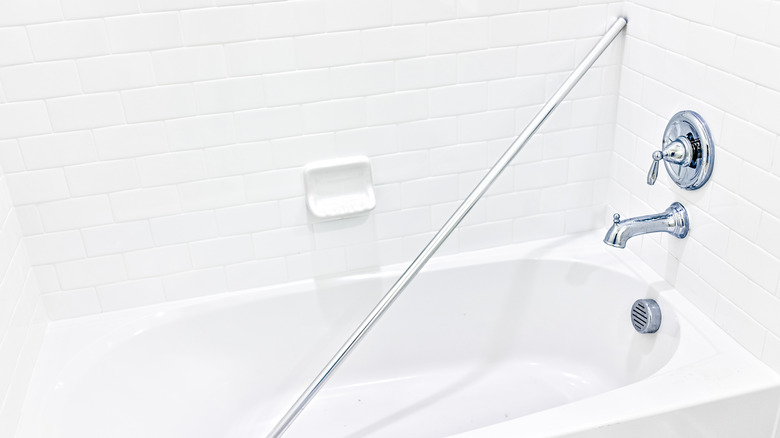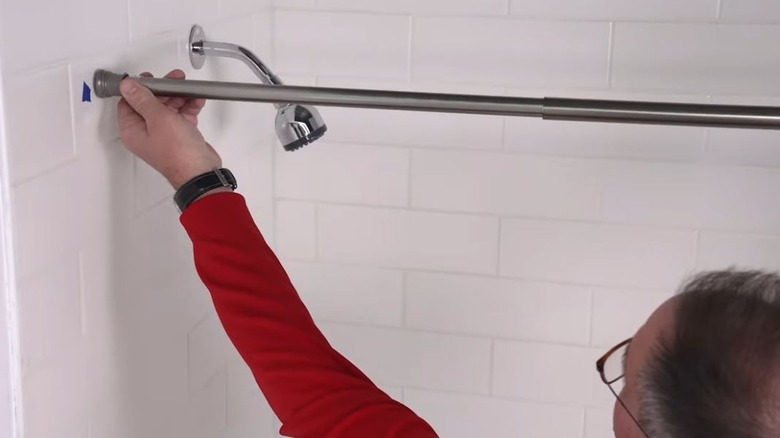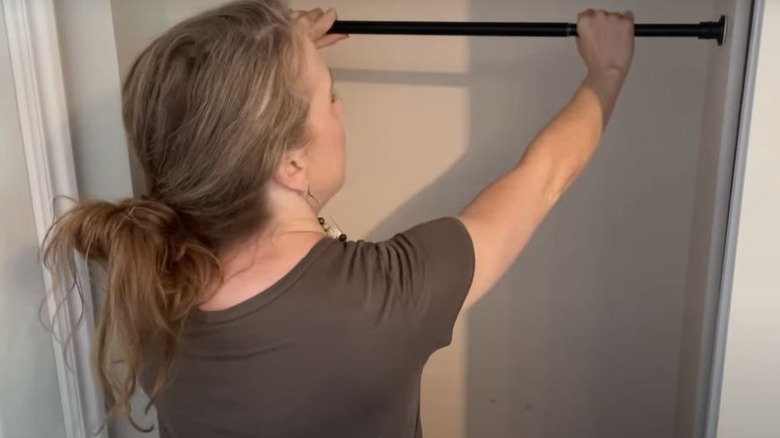Tips To Make A Tension Rod More Secure And Keep It From Falling Down
We may receive a commission on purchases made from links.
It's probably happened to you a few times. You were in the bathroom and nearly jumped out of your skin when the shower curtain tension rod came crashing down. Or perhaps the fall happened in the middle of the night and awoke you, forcing you to investigate. Tension rods in showers often fall because the walls are too slippery, but sometimes it seems like they fall for no reason at all. You can make your tension rod more secure to prevent it from falling by ensuring that it's tight, level, and creating friction.
Some homeowners skip the shower curtain tension rod altogether by drilling brackets into the walls, or adding a shower door instead of a shower curtain. Both options would obviously resolve the issue of a falling tension rod. However, if you'd rather not deal with brackets and nails, or you don't want to add a shower door, the following tips are great alternatives. As an added bonus, if you decide to repurpose your shower curtain rod in your home or garden, these tips can help in areas outside of a bathroom as well.
Ensure the rod is tight and level
This may seem like an obvious method of preventing a tension rod from falling, but some check the tightness and forget to check the level or vice versa. Tension rods are designed to be adjusted, so they need to be lengthened and leveled to fit securely between a pair of shower walls. If the rod is tightened, but not level, it likely will slide down and end up on the floor at some point. If it's level, but not well tightened, expect the same outcome.
Most tension rods can be adjusted simply by twisting them. However, a common mistake involves failing to twist the rod enough and, therefore, not creating enough tension to support the weight of the curtain. To secure the rod so that it will support its own weight and that of a curtain, continue to lengthen/tighten it while it's in place and gently tug down on the center. If it slips down, it's not tight enough; continue twisting until it stays secure after the tug test.
The tension rod must also be level to stay secured. One way to confirm this is by grabbing one of the tools every homeowner should have: a level, like the Workpro's mini pocket level. Place the level atop the rod to ensure it's even on both sides. You can also use the tile lines as a guide, assuming your shower has visible tile lines. It's best to adjust the tension while also checking the level, and make sure the walls are clean and dry before you install and adjust the rod.
Create more friction
Most tension rod end caps are made with a type of rubber to create friction against the walls to keep the rods in place, but some are made better than others. If you find yourself with a not-so-great set, and the rod keeps slipping down despite being taut and level, increasing the friction can come in handy; you can use rubber shelf liners or rubber grip pads.
If you already have rubber shelf liners in your drawers, you can cut a couple circles from the back corners that are the same size as the end caps, or purchase a new roll of liners in the smallest size. You don't necessarily have to search for the best shelf liners for cabinets and drawers, since that's not where you'll be using them. You'll also need contact cement or a comparable adhesive to glue the liners to the end caps. Once the liner circles have been glued to the end caps, place the rod back in place and test the tension. Add a second layer of liner if necessary.
Another option that can help create more friction is the $5 SoftTouch Self-Stick Non-Slip Surface Grip Pads. What's nice about these, compared to the rubber shelf liners, is that they come with their own adhesive. You won't need a super strong adhesive, since the tension of the rod will help keep the rubber in place between the walls and the end caps. The added layer of material, whether from the grip pads or shelf liners, on the end caps, can help keep the rod secure and prevent it from falling.


